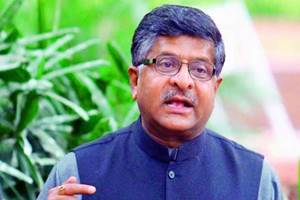Anxious to bring vigour to infrastructure investments, the Cabinet on Wednesday paved the way for the promised $75-billion UAE investments into India’s core-sector ventures and set the ball rolling for the long-stalled Rs 40,000-crore world-class exhibition-cum-convention centre (ECC) at Dwarka by transferring a 90-hectare plot to the industry ministry with the right to lease it to investors.
It also approved a scheme to aid rural housing, under which 1 crore pucca houses will be built at a cost of Rs 81,975 crore to the government by end-FY19.
While the approval for the India-UAE memorandum of understanding was ex-post facto — the MoU was signed on February 11 during the crown prince of Abu Dhabi Sheikh Mohammed Bin Zayed Al Nahyan’s India visit — communications and IT minister Ravi Shankar Prasad said the UAE’s participation in India’s National Infrastructure and Investment Fund would go a long way in ensuring “rapid expansion of next generation infrastructure, especially in railways, ports, roads, airports and industrial corridors/parks”. A joint India-UAE statement during the visit of Prime Minister Narendra Modi to the UAE in August 2015 had spoken of a UAE-India Infrastructure Investment Fund, the minister recalled, without elaborating on the structuring of the proposed mammoth UAE investments.
The ECC, which includes an air cargo complex, spread over 144 ha near New Delhi’s IGI Airport in Dwarka Sectors 25 & 26, has been held up for about four years owing to a dispute between the Delhi Development Authority and the Japan-funded DMICDC.
While the government entrusted DMICDC to execute the project, DDA, which had initially wanted to develop it, insisted the land be transferred to DMICDC at commercial rates, an idea that DMICDC thought was impractical and could kill the project.
The Cabinet has now resolved the issue by directing transfer of the 89.72 hectares of DDA land to DMICDC at a nominal sum of Rs1 within six weeks as a special case. The land, the ownership of which will vest with the department of industrial policy and promotion, would be treated as the Centre’s equity in the public-private partnership project, which could also get viability gap funding. The DIPP will lease/sub-lease the land to private investors, while DDA has been asked to provide the facility of mixed land use. After commissioning of the second phase of the project, the ECC with attendant facilities is expected to generate spending to the tune of Rs2 lakh crore, giving a fillip to the economy.
The rural housing scheme, to be implemented under the Pradhan Mantri Awaas Yojana-Gramin, would enhance the assistance per unit to Rs1.2 lakh in plain areas and Rs1.3 lakh in hilly/difficult areas. The additional financial requirement of Rs21,975 crore would be met through borrowing through the National Bank for Agriculture and Rural Development and this would be amortised through budget outlays after 2022, Prasad said.
In the Rs40,000-crore NIIF, the Centre will invest Rs 20,000 crore and hold up to 49% equity while the remaining stake would be offered to foreign and domestic strategic anchor partners. As a fund of funds, it would help make the required finances available to commercially viable projects, including stalled ones. By leveraging this, the NIIF could raise debt up to 10 times, or Rs4 lakh crore, over a period of time to ensure long-term fund flows to the infrastructure sector at reasonable cost. As a solution to the problem of elusive equity capital in the infrastructure sector, global sovereign wealth funds are expected to take the NIIF route to invest in India. FE had earlier reported that Abu Dhabi Investment Authority, Singapore’s Temasek and Russian Direct Investment Fund had evinced interest in NIIF.
The Cabinet on Wednesday also approved $1.5-billion World Bank support for the Swachh Bharat Mission (SBM) in rural areas. “The project basically provides for incentivising states on the basis of their performance in the existing SBM-Gramin,” the minister said. While it had been decided earlier to incentivise the states under this programme, the current approval provided for the mechanism of that through World Bank credit, the minister said.
